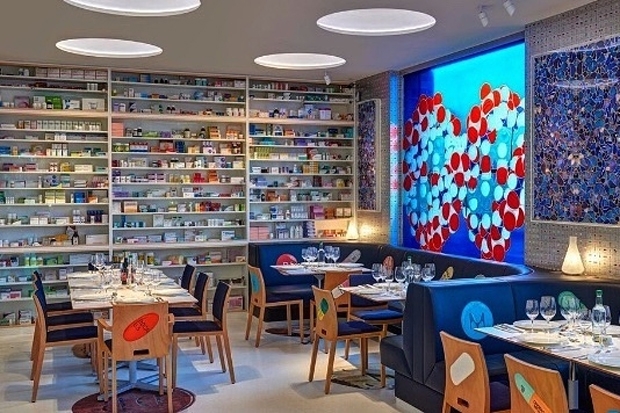Pharmacy 2 is the reanimated child of Damien Hirst; it lives inside the Newport Street Gallery in a forsaken patch of Lambeth by the railway arches. This makes it look, inevitably, like the set of The Bill, but with a painting of Damien Hirst on a nearby wall, which would surely confuse the Bill. Pharmacy 1 was, for five years until 2003, in Notting Hill. So we are already doing better. It is said that the Royal Pharmaceutical Society of Great Britain complained about Pharmacy 1, and worried it would confuse people looking for a real pharmacy, but I do not know if this was true. If it was, they were too stupid to live, even if they did eventually find a pharmacy.
The gallery looks like the interior of a shell. I ask a man behind a desk: is the gallery open? ‘To Damien, yes,’ he says. ‘He is bringing guests.’ Which I think means it is closed; except to Damien, who is bringing guests, which I am happy about but did not need to know. Up a curving white staircase to Pharmacy 2, and I am anxious, because I have to write an opinion about Damien Hirst’s art. And so I say: I don’t mind it. I’d rather own Jacopo Tintoretto’s Crucifixion than anything by Hirst; but I would rather read Hilary Mantel than the Mr Men. Hirst’s thing is to tell us we will die, but in Lego. This is his medium, which does not make it untrue; we will die, and we will die stupid. I do not hate infantilism that mocks infantilism; whatever you may think of the art, the metaphor by itself works, even if it does remind me of Woody Allen’s anxiety sweat. I also suspect that Hirst — unlike other false gods, specifically Lucian Freud, who dropped children the way apes drop shit and painted only his own essential ugliness — is a kind man; and I like that in an artist. I expect it.
In, and it’s a pharmacy, like Boots. Or Superdrug. Or Charles Saatchi’s bedroom, which once contained a fake pharmacy, which made him seem like an archetypal ageing male Jewish hypochondriac rather than a world-famous art dealer with infinite sexual possibilities. I suspect that was not his intention. Well, the joke is on him; have a plaster for a wound that will not heal. There are walls containing boxes of antidepressants and bottles of Listerine. There are bar stools shaped like pills; pills stitched into chairs; painting of pills on walls; painted pills inside glass walls. We are all sick, Hirst says, or we think we are or would like to be; now we shall celebrate it by spending £350 on a meal for four (including a carafe of wine), because who cares any more?
Pharmacy 2 is reminiscent of American films which dream, ever more luridly, of apocalypse with guns and fire and junk food; perhaps Hirst, who is now lurking dressed as a teenage boy, had to be prevented from opening a café in an ICU; or a tapas bar inside a cow. Pharmacy 2 is full of the kind of people who are dazzled by their own ability, under the correct set of circumstances, to visit Vauxhall. The lighting is superb. The food is by Mark Hix.
It is the best I have had from Hix, who wanders anxiously about; Pharmacy 2 is two days old. It is pristine, and served by waiting staff with nervous charm. We eat steaks, seafood, glorious pork crackling, delightful kale, and puddings: chocolate mousse, crème brûlée, pineapple cake and bread-and-butter pudding.
Hirst signs menus with a cartoon of a shark, wavy kisses, and his name. He is, I think, as surprised as we are that he should be the artist of the Age of Stupid; and this makes his pharmacy likeable.







Comments